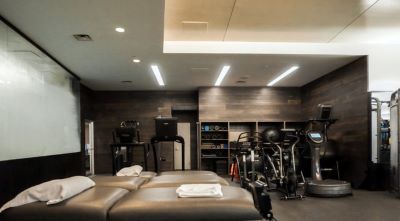While budget gym chains have struggled in recent years with well-known brands like Gold’s Gym and 24 Hour Fitness going under, many luxury fitness centers are expanding both offerings and square footage, according to sector experts. This means the high-end membership fitness sector is increasingly competitive, with brands working hard to differentiate.
While unique offerings, personalized service, and state-of-the-art equipment are important, luxury sector expert Alex Zilberman counsel’s client brands to prioritize something less obvious: the architecture and design of their venues.
“The experience of a fitness center brands depends a lot on the physical space itself,” says Zilberman, whose New York-based architecture firm AZA Design has designed not only multiple locations for Equinox, but also retail locations across the country for iconic luxury brands like Versace, Aston Martin, Aesop, and Jimmy Choo. “Luxury gyms have to offer a memorable experience that centers the members’ wellbeing, a visit they will want to repeat often and happily pay for with a subscription premium.”
Zilberman adds that his collaborations with luxury purveyors are always focused on translating brand identity into a striking built environment that captures the imagination. Then, as architect, he leverages precision-engineered and unitized components to ensure the highest-quality outcomes, completed on time and on budget across as many franchise locations as the client requires.
“Savvy fitness center brands are learning a lot from the retail sector,” adds Zilberman.
Images Courtesy of: AZA Design
Beautiful, biophilic, repeatable
As an example, Zilberman notes his admiration for Equinox Fitness Clubs and their deep understanding of the power of brand identity. Having served as architect for projects of this kind, he says luxury fitness chains with this orientation toward brand make ideal clients for his firm’s architectural approach.
Evincing corporate leadership’s greater understanding of how and why to carefully nurture their brand experience and integrate it into physical growth plans is what leads to success, according to Zilberman. It’s a worthwhile investment, he says, to develop an aesthetic that would work for each location, combining memorable details and biophilic elements that could be easily rolled out at each location while allowing for bespoke nods to the geographic region and local culture for appeal to that specific pool of potential members.
According to Zilberman, there are more benefits to utilizing prefabricated and unitized components: “Assembling systems in predetermined sizes enhances our ability to manage and optimize the proportions of the space, which is integral to creating a wellness-focused environment. The human body and mind respond to particular geometries as much as they do to other aspects of design that support wellbeing, such as natural materials, comfortable lighting, and good air filtration.”
Prefabrication also eases the design-construction process itself, making it easier for luxury fitness center brands to envision and execute their new locations. In this way, they can focus more on marketing and service — and less on managing the expansion process.
Feature Image Courtesy of: AZA Design
View the original article and our Inspiration here


Leave a Reply